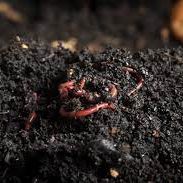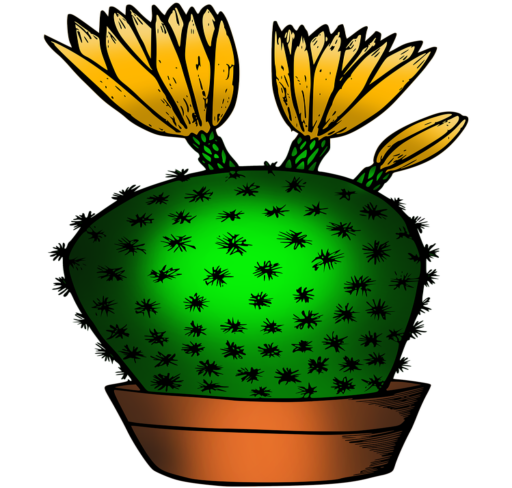Composting is an extraordinary soil improver, and is especially important for successful desert gardening.
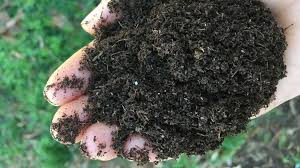
The soil is not, as many suppose, a dead, inert substance. It is very much alive and dynamic. It teems with bacteria, actinomycetes, fungi, molds, yeasts, protozoa, algae and other minute organisms. —J. I. RODALE, PAY DIRT
The desert is infamous for sparse soils that are often sandy with little organic matter. This lack of humus means that there is little to no food for microbes, so few endure in desert soil. Composting can change the soil.
The lack of humidity over long periods discourages microbes as well. There is no way for organic material to naturally decay in these soils because microorganisms are vital to this procedure. As a result, desert soils experience shortages that make them sterile, unable to retain water, and nearly lacking bacteriological life.
Refurbishing sparse desert soils to make them vigorous takes a long time, lots of enhancements, and microbes
Although the terms humus and compost are often used interchangeably, they are distinct soil components with different mechanisms of action; humus is created through anaerobic fermentation, while compost is the result of aerobic decomposition.
Encourage nutrient accessibility and soil makeup by using compost.
Compost has nutrients, trace elements and soil improvers, all freely available to plants.
Using compost significantly affects the bulk density of soil and contributes to its retention of moisture and nutrients.
Check the following for some Excellent Information on Composting https://en.wikipedia.org/wiki/Home_composting
Three Basic Components in a Compost Heap
Nitrogen to fuel the microorganisms needed to change organic matter into simpler forms. Two readily accessible sources of nitrogen for the composting are fresh manure and fresh grass clippings.
Soil provides the microorganisms necessary for breakdown, plus it helps to keep smell down while composting.
Organic matter provides carbon, trace minerals and food for the microorganisms. Plant residues, leaves, grass clippings, kitchen scraps, straw, and dry vegetation make up the carbon-rich ingredients of the compost.
Maintaining a good level of organic matter in the soil will solve a lot of common desert gardening problems. Plants that grow in rich, biologically active soils gain a greater ability to withstand drought or extreme heat. Organisms found in healthy and enriched soils contain microbes that can enter the plants to improve the uptake of soil moisture and fortify the immune system. When growing vegetables with a minimal amount of water, plant health is essential.
Maintaining Your Compost Pile
While compost maintenance is minimal, regularly turning the pile and sustaining optimal moisture for decomposition is crucial to your success. If you maintain your compost pile, you can expect usable compost in about six months.
Once a week, work the pile with a garden fork or shovel, making sure to turn it so the organic material from the bottom covers new additions on the top.
Add water to your pile to maintain dampness and speed decomposition. In the hot and dry desert, you might need to water as much as every other day.
If your pile is too wet, add shredded newspaper or dry leaves. This material will soak up the excess moisture and prevent mold from forming. Refrain from adding organic scraps until the pile returns to its normal level of dampness.
Compost Bins
There are hundreds of types of compost bins, heaps, and piles. No matter what variety you choose, place your compost in an area that is easy for you to access,
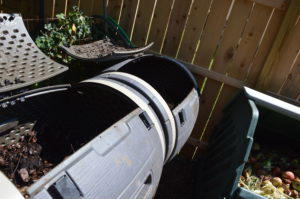
preferably in partial sun. The warmth will help the contents break down. The compost bin’s location is really important, especially in the desert. It should be protected in the late afternoon to help prevent dehydration.
One of the first tasks in making compost is choosing which type of composting system, i.e. bin or pile, you want to set up. There are many kinds of bins available, one of them being a cylindrical system that you can spin around so that you do not have to turn the contents with a pitchfork. This so-called “tumbler” style has the advantage of being tidy.
A Compost Pile, Enclosure or Bin Does Not need to be Impressive
The compost bin really does not have to be fancy to be effective. It is, after all, simply a container. The purpose of this container is mainly to make it easier for you to keep the composting materials gathered together and to keep it moist.
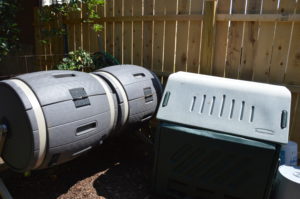
When not properly stacked and maintained in a pile, the materials will take much longer to break down, although eventually they will break down.
The Mass of a Properly Formed Pile is Critical to Fast Decomposition.
If you don’t have a pile of at least 3 x 3 x 3 feet, the ingredients just don’t heat as well.
Homemade compost containers can be built in many different ways. Some combination of wooden planks, cinder blocks, chicken wire and posts or pallets, for example, can be used to make your bin.
How to Make Compost
Even though compost is a great soil amendment, it is astonishingly easy to make. The basic idea is to stack compostable materials in layers in the compost bin, then keep the pile adequately watered. The right mix of materials and the correct amount of watering will put microorganisms to work for you to break down the pile. Turn the pile occasionally. The pile will heat up, and the materials will decompose.
What materials can be put in a compost bin? Any material that is natural and breaks down/ decomposes, is a possible contender for your compost bin. However, not all materials are suitable to add to the bin. Let’s start with some clear examples of good and not-so-good materials to use in your compost bin.
Brown materials are those that contain carbon, which is tough to break down. Examples are:
- Chopped autumn leaves.
- Shredded clean straw and hay.
- Torn newspaper.
- Nut shells.
- Woody chips and twigs used sparingly.
- Corn stalks.
Green materials contain nitrogen. They break down fast and heat up the composting pile. Examples are:
- Clover and grass clippings left behind after mowing.
- Potato peelings and similar kitchen scraps.
- Rotted manure.
- Coffee grounds.
- Fresh Weeds.
Things you should AVIOD putting in your compost pile and why:
- Yard trimmings treated with pesticides (could kill composting organisms).
- Meat, fish, eggs or poultry scraps (odor difficulties and pests).
- Diseased or insect-ridden plants (diseases or insects may increase).
- Fats, grease or oils (odor problems and pests).
- Bread, pasta, and cakes (attracts pests).
- Dairy Products (pests and wildlife).
- Plants that challenge and invade (Bermuda grass, bind weed, plants that won’t decompose but grow instead).
Basically, you’ll be building your pile in layers, as you would a lasagna. You will need to alternate between brown and green materials. Note that they do not have to be exactly brown and green in color (these are only terms).
When your layers are in place, the microorganisms and worms do most of most of the work, you only need to assist them by watering the heap once in a while. There’s a subtle balance to find between letting the materials dry out and making them waterlogged. You don’t want either of those extremes. Experiment with the proportions.
You can also help out the microorganisms by turning the pile once in a while with a pitchfork (or by tumbling if you have a tumbler-style bin), to keep the pile well-aerated. Turning also makes the materials break down in a more uniform way. The center of the pile is where the heat is.
The idea behind turning the pile is to move some of the material around the edges into the center, so as to give it equal time to cook. When the materials have broken down completely, you are almost ready to put to use the world’s best soil amendment.
Knowing When Your Compost is Ready
When your compost is ready, you’ll have a dark brown, almost black soil-like layer at the bottom of your bin. It should have a spongy texture and will be rich in nutrients. Spreading the finished compost into your gardens significantly improves soil quality by helping it retain moisture and suppressing weeds. It also reduces the need to use chemical fertilizers and pesticides.

Vortex Brewer – VB15 Compost Tea System – …
VB15 Vortex Brewer® 15 gallon tank Completely pre-plumbed and assembled 100-watt air p… [More]
